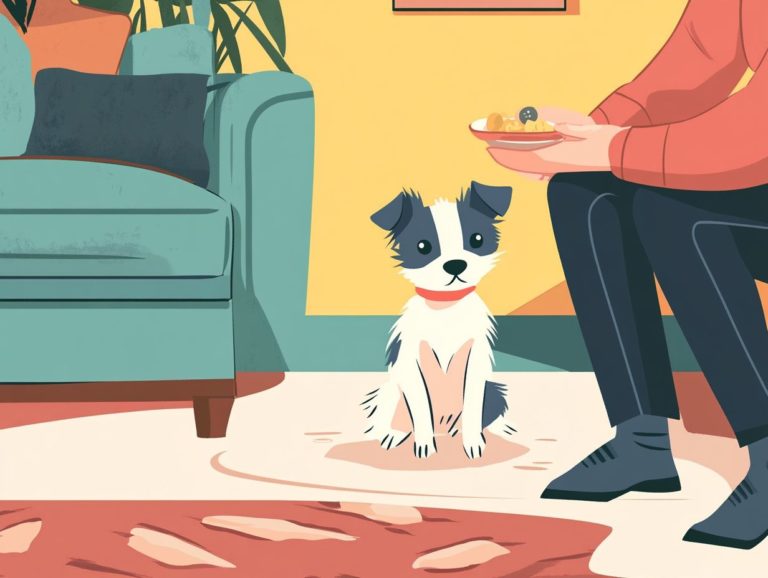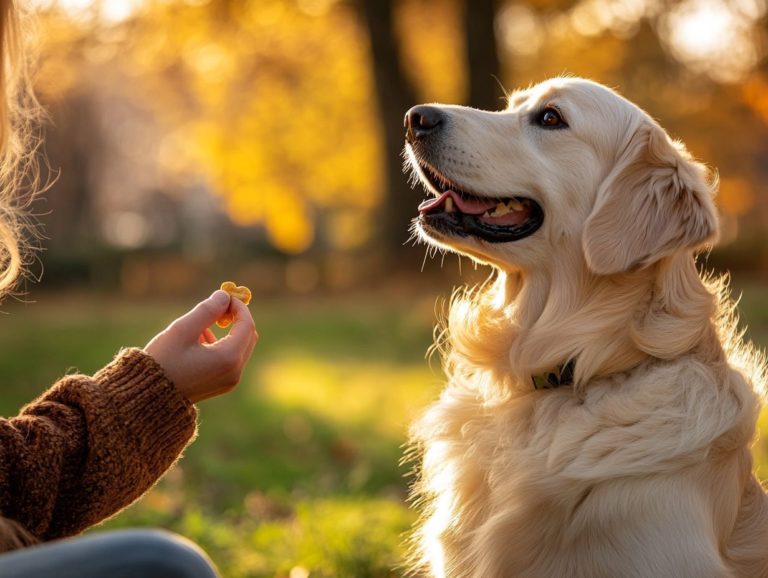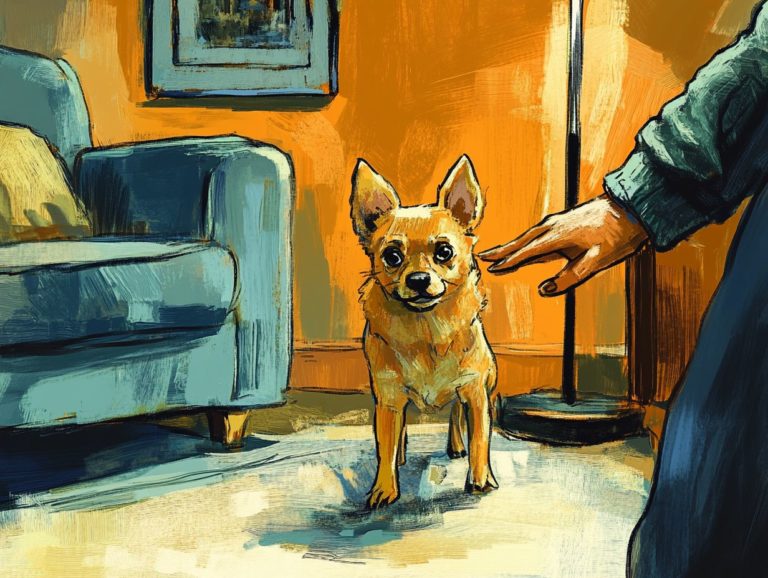5 Techniques for Building Confidence in Anxious Dogs
Building confidence in anxious dogs is crucial for their well-being and happiness. Many pet owners face the challenges that come with a nervous pup, but with the right techniques, you can help your furry friend flourish. Let s dive into these strategies and transform your anxious pup into a confident companion!
This guide delves into five effective strategies, encompassing positive reinforcement training, socialization, and mental stimulation. It also highlights the causes and signs of anxiety in dogs, along with guidance on when to seek professional assistance.
By the end of this journey, you ll be well-equipped to nurture your dog s confidence and enhance their overall quality of life.
Contents
- Key Takeaways:
- 1. Positive Reinforcement Training
- 2. Socialization with Other Dogs and People
- 3. Exercise and Mental Stimulation
- 4. Calming Supplements and Aids
- 5. Consistency and Patience
- What Causes Anxiety in Dogs?
- Frequently Asked Questions
- What are the 5 techniques for building confidence in anxious dogs?
- How can creating a safe environment help build confidence in anxious dogs?
- What is positive reinforcement training and how does it help anxious dogs?
- Why is socialization important for anxious dogs?
- How does getting used to things that scare them work in building confidence for anxious dogs?
- Why is exercise crucial for building confidence in anxious dogs?
Key Takeaways:
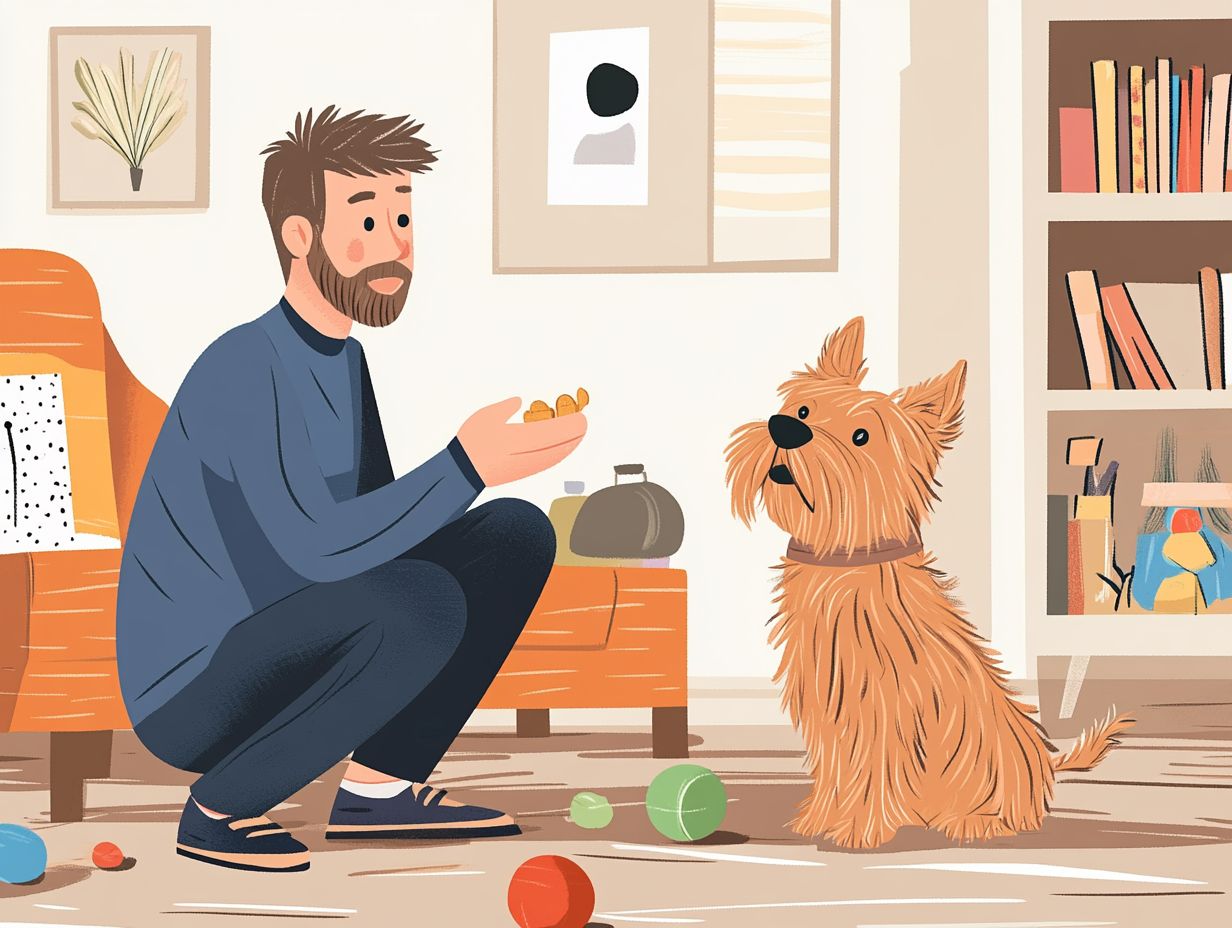
- Consistent positive reinforcement training is key in building confidence in anxious dogs.
- Socializing with other dogs and people helps reduce anxiety and build confidence in dogs.
- Regular exercise and mental stimulation improve overall well-being and confidence in anxious dogs.
1. Positive Reinforcement Training
Positive reinforcement training is an incredibly effective way to teach your dog desirable behaviors. By building trust and using treats, you create a predictable environment that fosters confidence, especially in fearful dogs. To further assist in this process, consider exploring techniques to calm anxious pets before training, as this method can significantly alleviate dog anxiety and improve their emotional responses to frightening triggers.
In this approach, you can employ techniques like clicker training. This involves using a distinct sound that signals to your dog they ve done something right, followed promptly by a reward. Keep your training sessions enjoyable and concise to maintain your dog s focus, rewarding good behavior with small, tasty treats like chicken, cheese, or even commercial training snacks.
Consistency is crucial; pairing praise with treats reinforces the bond you share with your dog. This mutual understanding paves the way for open communication and builds trust, transforming the training experience into an enjoyable journey that enhances your dog s confidence and comfort in various situations.
2. Socialization with Other Dogs and People
Socialization with other dogs and people is essential during the important time for socializing. This exposure helps fearful dogs build confidence and alleviates anxiety by introducing them to various environments and diverse body language cues.
During these formative months, your dog must interact with a range of stimuli different people, sounds, and locations. This approach cultivates a well-rounded individual who feels at ease in various settings.
Gradually introduce new experiences, utilizing positive reinforcement to nurture curiosity and bravery while steering clear of overwhelming fear.
Pay close attention to your dog’s body language. Signs of discomfort, like a tucked tail or lowered ears, signal that a gentler approach is needed. Encouraging safe, meaningful interactions whether through organized playdates or structured training classes is crucial in fostering a secure, confident adult dog ready to thrive in the world around them.
3. Exercise and Mental Stimulation
Integrating exercise and mental stimulation into your dog’s daily routine is crucial for their health and happiness. Activities like agility training and engaging food puzzles provide both physical and cognitive challenges that help reduce anxiety. For more tips, consider these tricks to help anxious pets feel secure and bolster confidence in fearful dogs.
These varied activities work hand in hand, allowing your dog to burn off excess energy while sharpening their problem-solving skills. Agility training not only offers a fantastic workout but also strengthens the bond between you and your dog through shared challenges.
Food puzzles stimulate your dog s mind, encouraging them to tap into their natural instincts to uncover rewards, which can be incredibly satisfying. This combination doesn t just redirect negative behaviors; it builds a sense of accomplishment, leading to a calmer and more balanced pet.
By incorporating these elements into daily life, you can create a more harmonious environment for both you and your dog.
Start implementing these strategies today to help your furry friend thrive!
4. Calming Supplements and Aids
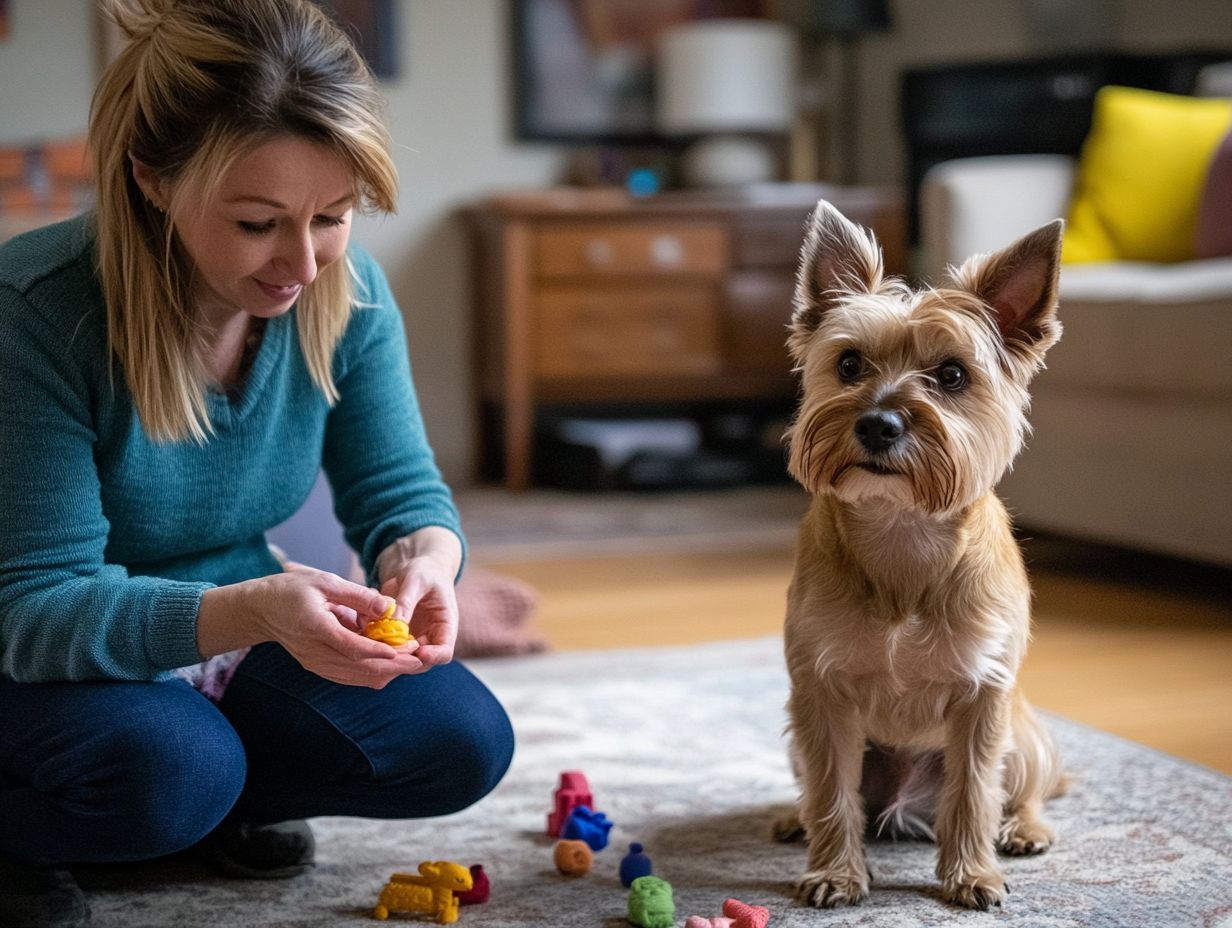
Calming supplements and aids can be essential in managing your dog s anxiety. They provide relief by gently exposing them to situations that cause anxiety while enhancing your training techniques.
You can also explore methods like desensitization and teaching your dog to feel safe. These approaches are part of the top training techniques to reduce pet anxiety, effectively alleviating anxiety by gradually introducing your dog to fear-provoking stimuli in a controlled environment.
Many pet owners have found success with natural calming supplements like L-theanine and valerian root, which promote relaxation without causing drowsiness. Always check with your vet before trying new supplements to keep your furry friend safe and happy!
5. Consistency and Patience
Consistency and patience are your best friends for successful dog training. These elements assist in behavior modification and create a trustworthy environment crucial for building lasting confidence in fearful dogs.
Imagine you have a timid rescue dog who flinches at sudden movements. By consistently using gentle cues and positive reinforcement during training sessions, you can help your dog understand that not every gesture poses a threat.
Over time, your fearful pup might surprise you by approaching strangers and even initiating playful interactions. A steady training routine can transform anxious behaviors and cultivate trust.
Remember, nurturing a well-adjusted pet hinges on a delicate balance of patience and unwavering dedication.
What Causes Anxiety in Dogs?
Wondering what might be causing your dog’s anxiety? Dog anxiety can arise from many sources, such as environmental factors, past traumas, and specific triggers that elicit strong emotional responses.
Loud noises like thunderstorms or fireworks can send your furry friend into a panic. Similarly, changes in routine or household dynamics whether welcoming a new family member or relocating can create uncertainty for your dog.
Experiences of abandonment or harsh training practices may leave lasting emotional imprints, resulting in persistent anxiety. Effective environmental management is vital in addressing these challenges.
Creating a safe haven, incorporating calming aids like soothing music or pheromone diffusers, and establishing consistent daily routines can significantly alleviate anxiety. By identifying your dog s specific triggers and nurturing a stable environment, you can enhance their emotional well-being.
How Can Anxiety Manifest in Dogs?
Anxiety in dogs can show up in various behaviors, reflecting their emotional responses to surrounding stressors. You might notice changes in body language, vocalizations, or even destructive actions.
If your dog is cowering, trembling, or pacing excessively, these behaviors often indicate fear or distress. They may vocalize their discomfort through whining, incessant barking, or growling, all of which communicate anxiety.
Recognizing these signs is crucial; addressing issues early can lead to more effective behavior modification. By understanding subtle cues and specific reactions, you can create an environment that alleviates their stressors.
This proactive approach can help you cultivate a calmer, more balanced canine companion.
What Are the Signs of a Confident Dog?
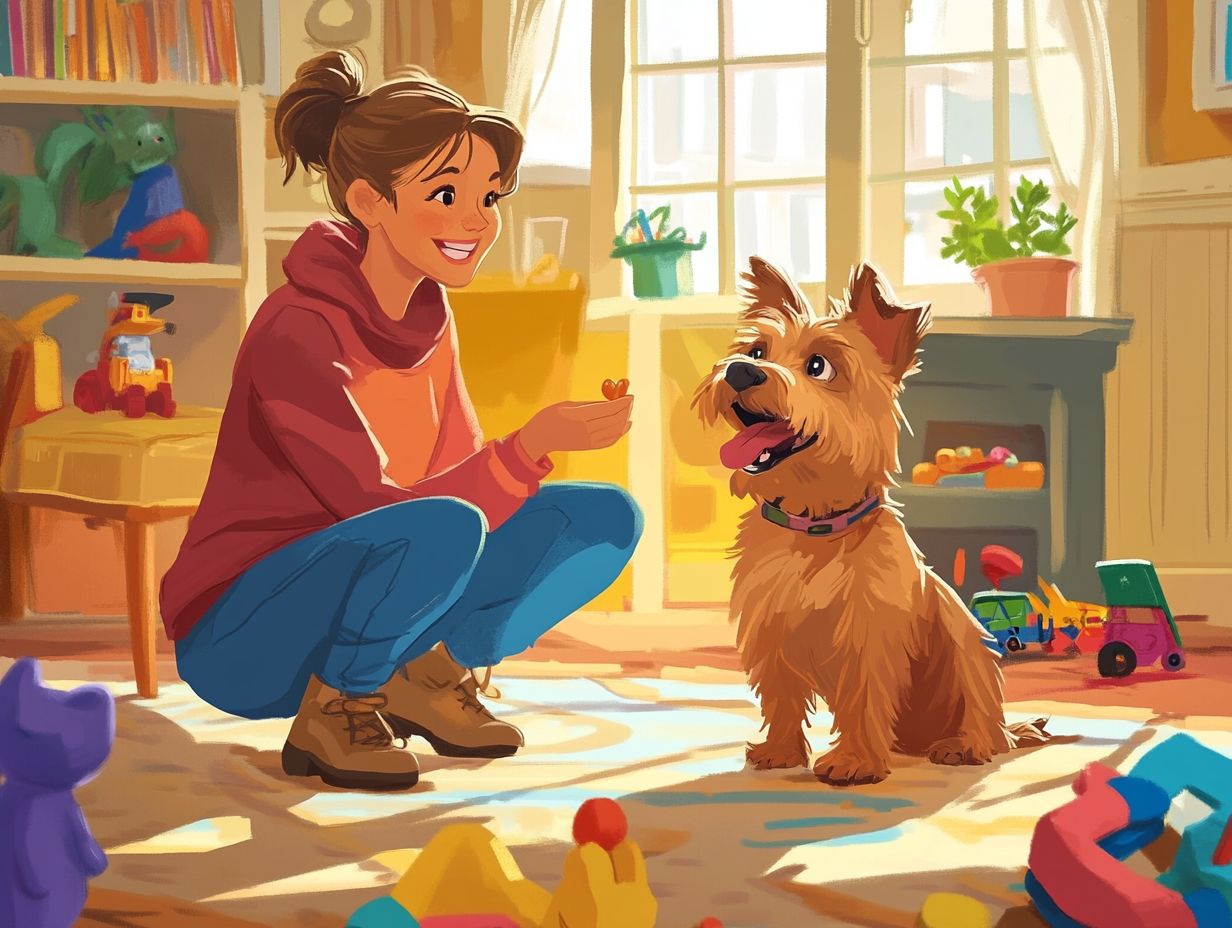
A confident dog displays positive signs that are hard to miss. Look for relaxed body language, keen curiosity, and a calm demeanor.
Indicators of confidence also include upright posture, a wagging tail held at a neutral position, and open, relaxed facial expressions. In various environments like parks or pet-friendly events confident dogs approach strangers and fellow canines with enthusiasm, engaging in playful interactions instead of showing fear or aggression.
Even in stressful situations, a confident dog remains unfazed by loud noises or sudden movements. This showcases their ability to adapt and feel secure in diverse circumstances. Their strong sense of assurance enhances their quality of life and paves the way for positive experiences in social settings.
When Should a Professional Be Consulted for an Anxious Dog?
Consulting an expert, like a dog trainer or behaviorist, may be essential when your dog s anxiety escalates into serious behavioral challenges. This could indicate that expert help or even anxiety medication is necessary for effective management.
Recognizing the signs of distress in your canine companion is paramount. If you notice trembling, excessive barking, or avoidance behaviors, it s a clear sign that your dog is suffering from anxiety.
In these situations, professionals play a crucial role in evaluating your dog s condition and crafting tailored training plans that cater to their unique needs. Trainers often employ positive reinforcement techniques rewarding good behavior with treats or praise while behaviorists dig deeper to uncover the root causes of anxiety, such as scary triggers. This ensures a holistic approach.
By collaborating with these experts, you can restore balance to your pet s life and arm yourself with the tools needed for ongoing support.
How Can a Dog Owner Help Build Confidence in Their Anxious Dog?
Want to boost your dog’s confidence? Here’s how you can help! As a dog owner, you have the remarkable ability to assist your anxious dog by using training techniques specifically for anxious breeds to build trust and confidence.
By employing techniques for building a bond with anxious pets like rewarding good behavior with treats or praise, gently introducing them to situations they fear, and ensuring a steady socialization process, you can nurture trust and alleviate anxiety.
Creating predictable life routines and providing a safe space for your pet can significantly enhance their journey toward confidence. Engaging in stimulating activities, such as food puzzles or agility training, not only challenges their minds but also fosters a sense of accomplishment.
Take your dog on exciting outings to dog parks or arrange playdates with other friendly dogs to further aid their socialization. This helps diminish the fear of new interactions. Remember, using treats and praise to reward brave behaviors is essential; this reinforces positive experiences and employs training techniques to manage aggression to gradually build their self-assurance.
Ultimately, patience and persistence are your best allies in confidence building. Every small step you take contributes to fostering a more confident companion.
What Are the Benefits of Having a Confident Dog?
Having a confident dog offers a wealth of benefits that elevate your companionship to new heights. You’ll notice improved emotional responses, successful changing behavior, and enhanced socialization. These factors create a more enjoyable and fulfilling relationship.
A confident dog is typically more relaxed and adaptable. This makes outings and playdates significantly less stressful for everyone involved. This ease enriches your dog’s interactions and enhances their ability to participate in canine sports. It also paves the way for new friendships with other animals and humans alike.
When your dog feels secure, it s more likely to engage positively with strangers. This reduces pesky anxiety-driven behaviors and allows for better obedience training opportunities. A confident dog tends to attract admiration and curiosity, enhancing your own social experiences.
This strong bond makes your life more enjoyable and exciting! It fosters stronger connections and enriches the adventures you share together, whether through exercise or engaging in gentle exposure activities.
Frequently Asked Questions
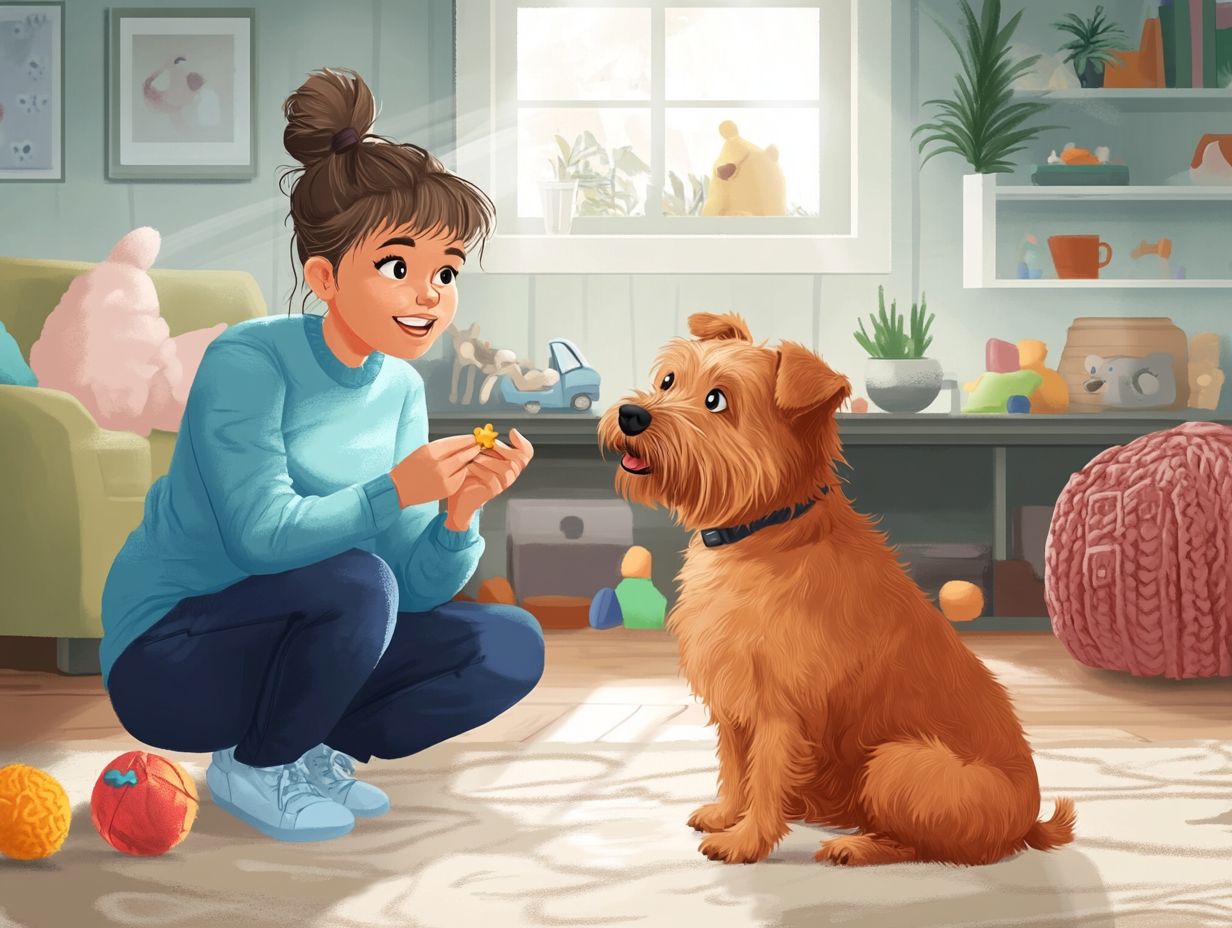
What are the 5 techniques for building confidence in anxious dogs?
The 5 techniques for calming anxious pets are: creating a safe environment, positive reinforcement training, socialization, getting used to things that scare them, and exercise. These methods include keeping the environment calm to reduce anxiety.
How can creating a safe environment help build confidence in anxious dogs?
Creating a safe environment includes providing a comfortable space for the dog to retreat to when feeling anxious. It also involves removing potential stress triggers and establishing a daily routine. Additionally, implementing socialization techniques for anxious pets can help reduce the dog’s overall anxiety and build their confidence over time.
What is positive reinforcement training and how does it help anxious dogs?
Positive reinforcement training involves rewarding desired behaviors with treats, praise, or play. This type of training boosts a dog’s confidence by providing them with a sense of accomplishment while building a strong bond with their owner through effective training techniques.
Socializing anxious dogs with others during the socialization period can help them become more comfortable in new situations. It reduces fear and anxiety while teaching them appropriate behavior and building confidence around others.
How does getting used to things that scare them work in building confidence for anxious dogs?
Desensitization involves gradually exposing a dog to their triggers in a controlled environment and rewarding calm behavior. This process helps the dog become more comfortable and less reactive in situations that once caused anxiety.
Why is exercise crucial for building confidence in anxious dogs?
Regular exercise helps reduce stress and releases endorphins, improving a dog’s overall mood and confidence. It also provides an outlet for excess energy and can help reduce destructive behaviors that may stem from dog anxiety.

